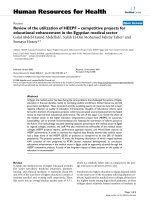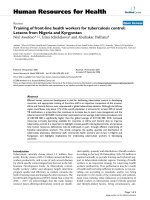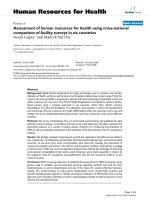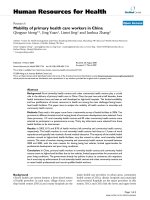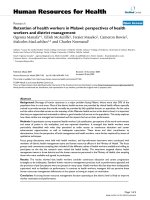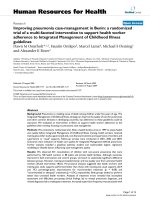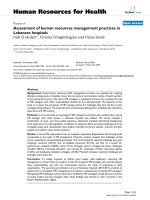Báo cáo sinh học: " Repressor of temperate mycobacteriophage L1 harbors a stable C-terminal domain and binds to different asymmetric operator DNAs with variable affinity" ppt
Bạn đang xem bản rút gọn của tài liệu. Xem và tải ngay bản đầy đủ của tài liệu tại đây (355 KB, 8 trang )
BioMed Central
Page 1 of 8
(page number not for citation purposes)
Virology Journal
Open Access
Research
Repressor of temperate mycobacteriophage L1 harbors a stable
C-terminal domain and binds to different asymmetric operator
DNAs with variable affinity
Tridib Ganguly, Amitava Bandhu, Partho Chattoraj, Palas K Chanda,
Malabika Das, Nitai C Mandal and Subrata Sau*
Address: Department of Biochemistry, Bose Institute, P1/12 CIT Scheme VII M, Kolkata – 700 054, West Bengal, India
Email: Tridib Ganguly - ; Amitava Bandhu - ;
Partho Chattoraj - ; Palas K Chanda - ; Malabika Das - ;
Nitai C Mandal - ; Subrata Sau* -
* Corresponding author
Abstract
Background: Lysogenic mode of life cycle of a temperate bacteriophage is generally maintained
by a protein called 'repressor'. Repressor proteins of temperate lambdoid phages bind to a few
symmetric operator DNAs in order to regulate their gene expression. In contrast, repressor
molecules of temperate mycobacteriophages and some other phages bind to multiple asymmetric
operator DNAs. Very little is known at present about the structure-function relationship of any
mycobacteriophage repressor.
Results: Using highly purified repressor (CI) of temperate mycobacteriophage L1, we have
demonstrated here that L1 CI harbors an N-terminal domain (NTD) and a C-terminal domain
(CTD) which are separated by a small hinge region. Interestingly, CTD is more compact than NTD
at 25°C. Both CTD and CI contain significant amount of α-helix at 30°C but unfold partly at 42°C.
At nearly 200 nM concentration, both proteins form appreciable amount of dimers in solution.
Additional studies reveal that CI binds to O
64
and O
L
types of asymmetric operators of L1 with
variable affinity at 25°C. Interestingly, repressor – operator interaction is affected drastically at
42°C. The conformational change of CI is most possibly responsible for its reduced operator
binding affinity at 42°C.
Conclusion: Repressors encoded by mycobacteriophages differ significantly from the repressor
proteins of λ and related phages at functional level but at structural level they are nearly similar.
Background
Repressor of a temperate bacteriophage maintains its lys-
ogenic mode of life cycle generally by turning off the tran-
scription of its lytic genes and simultaneously by keeping
its own synthesis on. The lysis – lysogeny decisions in
lambda and related phages are in fact controlled by bind-
ing of two antagonistic transcriptional repressors (e.g. CI
and Cro in lambda phage) to two master operators over-
lapped with divergent early promoters [1]. Nearly similar
regulatory circuits controlling the lysogenic – lytic devel-
opments have also been detected in phages P2 [2], Mu [3],
HK022 [4], Phi 80 [5], and CTXΦ [6]. Lambda repressors
Published: 28 June 2007
Virology Journal 2007, 4:64 doi:10.1186/1743-422X-4-64
Received: 26 January 2007
Accepted: 28 June 2007
This article is available from: />© 2007 Ganguly et al; licensee BioMed Central Ltd.
This is an Open Access article distributed under the terms of the Creative Commons Attribution License ( />),
which permits unrestricted use, distribution, and reproduction in any medium, provided the original work is properly cited.
Virology Journal 2007, 4:64 />Page 2 of 8
(page number not for citation purposes)
bound to O
L
and O
R
operators octamerize and the result-
ing DNA loop enhances the repression of early promoters
and stably maintains lysogeny [7]. Interestingly, the
mechanism of actions of repressors of coliphages P1 and
P7 [8,9], mycobacteriophages L5 and Bxb1 [10], and B.
subtilis phage Phi105 [11] differ considerably from those
of lambda and related phages. Repressors of these phages
bind to multiple asymmetric operators instead of sym-
metric operators. Thus far most repressors of the second
group phages had not been studied at length.
Mycobacteriophage L1, homoimmune to mycobacteri-
ophage L5, utilizes M. smegmatis as its host [10]. Its repres-
sor gene was identified, cloned and characterized to some
extent [12-15]. L1 repressor (CI) was found 100% identi-
cal to L5 repressor at amino acid sequence level. An L1
promoter [16] that binds to CI specifically was also found
100% identical to L5 early promoter P
left
[10] at nucleo-
tide level. An asymmetric operator (5'GGTGGCTGT-
CAAG) that overlaps P
left
in fact interacts with CI.
Interestingly, L5 harbors eleven more operators of the
above type at different places of its genome. A second pre-
dominant group which consists of seven other identical
L5 operators (5'GGTGGATGTCAAG) differs from the
former group by a single base [10]. There are eleven other
asymmetric operators in L5 and they carry 1 – 2 base
changes at different positions except 6
th
position. Among
these 3
rd
group operators, five operators interact with CI.
L5 operators were shown not only to repress the transcrip-
tion from its early promoters but also to stop the elonga-
tion of L5 transcripts. Additional studies reveal that
affinity of CI to an L1 operator (5'GGTGGCTGTCAAG)
decreases notably at 42°C compared to that at 32°C [14].
A mutant CI devoid of its helix-turn-helix (HTH) DNA
binding motif does not bind to operator at 32° – 42°C
[15], whereas another mutant CI carrying a point muta-
tion at its C-terminal end, binds to operator at 32°C but
not at 42°C. Thus far, little study was carried out to under-
stand the structure of L1/L5 repressor and its molecular
mechanism of interaction with asymmetric operator
DNA.
Our preliminary studies indicate that an L1 DNA region is
100% identical to an L5 DNA region harboring L5 gp64
gene and an upstream operator (5'GGTGGATGTCAAG)
[10]. In this communication, we have designated the L1
DNA fragments carrying operators 5'GGTGGATGTCAAG
and 5'GGTGGCTGTCAAG as O
64
and O
L
, respectively,
and shown that CI binds to former operator more strongly
than latter operator. Interestingly, repressor-operator
interaction is drastically affected at 42°C. We also report
for the first time that L1 repressor possesses two domains
(an N-terminal domain, NTD and a C-terminal domain,
CTD) at room temperature. CTD is comparatively more
compact than NTD at room temperature. Both CI and
CTD carry significant amount of α-helix at 30°C but
unfold partly at 42°C. Both proteins also form apprecia-
ble amount of dimers in solution.
Results and Discussion
L1 repressor possesses two domains
Many repressors possess domains, which perform distinct
function [1,6,9,19,20]. To detect domain (s) if present any
in CI, limited proteolysis of His-CI was performed with
chymotrypsin and trypsin separately according to stand-
ard techniques. As shown in Fig. 1A, two major protein
fragments of nearly 16 and 10.5 kDa (designated c and e,
respectively) were generated from intact repressor (desig-
nated a) upon digestion with chymotrypsin for 2 mins at
25°C. While fragment c remained undigested over the
entire period of digestion, fragment e was degraded grad-
ually followed by the appearance of some smaller frag-
ments designated f and g. Some less prominent fragments
such as fragments b and d were not seen after 5 min. Sur-
Domains of L1 repressor. Figure 1
Domains of L1 repressor. Chymotrypsin (A) and trypsin
(B) digested His-CI fragments were analyzed by Tris-Tricine
SDS-16.5% PAGE followed by silver staining. Molecular
masses (in kDa) of marker proteins are shown at the left side
of gel. 'Chy' and 'Try' indicate chymotrypsin and trypsin,
respectively whereas, a – h indicate intact repressor, differ-
ent digested fragments of repressor, respectively. N-terminal
ends of fragments c and h were sequenced. (C) Western
blotting analysis of chymotrypsin/trypsin digested His-CI frag-
ments from 2 and 30 mins incubations by a standard proce-
dure as indicated in Materials and method. (D) Summary of
proteolysis. The putative domains of CI and its amino acid
residues involved in formation of hinge, NTD and CTD are
indicated.
Virology Journal 2007, 4:64 />Page 3 of 8
(page number not for citation purposes)
prisingly, the fragment c was not digested further even for
~12 h incubation with chymotrypsin though its cleavage
sites are distributed all over CI (not shown). Further anal-
ysis showed that only fragments d and e of 2 mins diges-
tion products reacted with anti-his antibody along with
the intact repressor (Fig. 1C). No other fragments derived
from 2 and 30 mins digestions interacted with anti-his
antibody. Sequence of the first ten N-terminal amino acid
residues of fragment c was determined to be GGRLT-
TRQIV. These 1–10 amino acid residues were found 100%
identical to the 92 – 101 (equivalent to 56 – 65 amino
acid residues of CI) amino acid residues of His-CI. As the
size of fragment c appeared unchanged over the whole
digestion period and fragment d and e disappeared with
increasing time of digestion, fragments f and g might have
originated from the internal regions of fragment d and/or
e.
Contrary to chymotrypsin digestion, approximately six
protein fragments having molecular weights in the range
of ~23 to ~15 kDa were generated with trypsin at early
period of digestion (Fig. 1B). All these fragments except
one (designated h) disappeared gradually with the longer
time of digestion. Intensity of fragment h having molecu-
lar mass of ~15 kDa increased with time and reached to
maximum at 30 min. Analysis of 2 and 30 mins digestion
samples revealed that none of the fragments reacted with
anti-His antibody whereas the full-length did (Fig. 1C).
The first ten N-terminal amino acid residues of fragment
h were found to be QIVQQNWPWD. These amino acid
residues in fact correspond to 99 – 108 amino acid resi-
dues of His-CI (equivalent to 63 – 72 amino acid residues
of CI). Taking together, the data indicate that CI indeed
possesses domain structure and the most flexible or
exposed region of CI is located around its 55 – 63 amino
acid residues. The putative exposed region is designated as
'hinge' region here. The hinge region of CI is thus flanked
by an NTD and a CTD that encompass through ~1 – 54
and ~64 – 183 amino acid residues, respectively (Fig. 1D).
As the putative HTH motif is located within 34 – 53
amino acid residues of CI [13,15], hinge region may not
be extended much in its left ward direction but may be
extended up to the 106
th
residue at right ward direction.
The 107
th
residue, a tryptophan is buried in His-CI (equiv-
alent to 70
th
tryptophan residue in CI) as evident from
analysis of chymotrypsin digested fragments of His-CI. It
is interesting to note that size of putative hinge region in
L1 CI is less than half of that of λ phage [1]. The data also
indicate that CTD is comparatively more compact than
NTD at room temperature.
CD spectra of CI, His-CI and CTD
CD spectra measurement of proteins can predict about
their secondary structural elements and conformational
changes under different environmental conditions. To get
clues about the secondary structures in CI, His-CI, and
CTD and also to see the effect of temperature on their con-
formations, their CD spectra (200–260 nm) were
recorded at different temperatures. As shown in Fig. 2, the
spectrum of His-CI obtained at 30°C shows a peak of
large negative ellipticity at ~208 nm. This indicates that
there is a substantial amount of α-helical structure in His-
CI at 30°C. Analysis of the spectrum by a software pro-
gram CDNN [21] in fact showed that there were about
22.2% α-helix, 23.3% β strand, and 37.2% coil in His-CI.
Native CI also shows nearly identical CD spectrum at
30°C and was found to carry ~29.9% α-helix, 20% β
strand, and 34.2% coil (data not shown). The peak of the
CD spectrum of His-CI was however reduced substantially
at 42°C (Fig. 2). There were nearly 23% reduction of α-
helical structure and concomitant ~10% increase of ran-
dom coil in His-CI when temperature was increased from
30° to 42°C. The CD spectrum of CTD recorded at 30°C
also showed a peak of negative ellipticity near 208 nm
which was reduced substantially when the incubation
temperature was raised to 42°C. This temperature
increase was found to reduce the α-helical content in CTD
by nearly 34%, whereas random coil increased to about
26% under identical condition. The data together indicate
that there are considerable amount of unfolding as well as
conformational change of each of His-CI and CTD at
42°C compared to those at 30°C.
CD-spectra of His-CI and CTDFigure 2
CD-spectra of His-CI and CTD. Far UV CD-spectra of
His-CI and CTD (64–183 amino acid residues) were meas-
ured at 30° and 42°C separately in Buffer A [50 mM phos-
phate buffer (pH-6.0), 50 mM NaCl, 1 mM EDTA, 5%
glycerol].
Virology Journal 2007, 4:64 />Page 4 of 8
(page number not for citation purposes)
Both CI and CTD dimerize in solution
To reveal the oligomeric status of CI and CTD in solution,
both gel filtration chromatography and glutaraldehyde
crosslinking were carried out according to the standard
methods [18]. As shown in Fig. 3A, passage of ~20 μM
His-CI through gel filtration column produced two peaks.
In comparison with the elution profiles of some standard
proteins (also shown in Fig. 3A), the peaks seemed to be
consistent with monomeric (~25 kDa)- and dimeric (~50
kDa) forms of His-CI, respectively. Gel filtration chroma-
tography of ~20 μM CTD also produced two peaks which
correspond to dimeric (~28 kDa) and monomeric (~14
kDa) CTD, respectively (Fig. 3A). The dimeric His-CI/CTD
species, however, was clearly seen when glutaraldehyde-
treated His-CI/CTD solution (500 nM) was analyzed by
SDS-PAGE (Fig. 3B). Taken together, the data indicate that
both CI and CTD form dimers in solution at hundred
nanomolar concentration.
It is interesting to note from the gel filtration analyses that
monomeric His-CI and dimeric CTD are the predominant
species in solution. The exact reason of the increased
amount of monomeric His-CI or the reason of formation
of the elevated level of dimeric CTD in solution is not very
clear at this moment. It is possible that a part of dimeric
His-CI had been destroyed during its run through gel fil-
tration column and removal of N-terminal region of His-
CI augments the dimerization of CTD by bringing out
some conformational change in latter.
CI binds more strongly to O
64
operator than O
L
operator
The O
64
and O
L
types of operators are predominant in L5
[10] and also possibly in L1. To understand the relative
affinity of CI to such operators, equilibrium binding of CI
as well as dissociation kinetics of repressor-operator com-
plexes was studied by separate gel shift assays. Figs. 4A and
4B show the gel pictures as well as the corresponding plots
of equilibrium binding of CI to O
64
and O
L
, respectively.
At CI concentration that produces 50% saturation of
input O
64
operator, the apparent equilibrium dissociation
constant is nearly 140 nM. In contrast, apparent equilib-
rium dissociation constants for CI – O
L
interaction is ~370
nM. The data suggest that affinity of CI to O
64
is nearly 2.5
fold higher than that of CI to O
L
.
Fig. 4C shows the kinetics of dissociation of O
64
– and O
L
– CI complexes. Both the dissociation reactions appeared
to be the first order in nature. While half-life and dissoci-
ation rate constant for dissociation of CI-O
64
complex
were ~233 min and 2.97 × 10
-3
s
-1
, respectively, and for CI-
Oligomerization of His-CI and CTDFigure 3
Oligomerization of His-CI and CTD. (A) Gel filtration analysis. Each protein was loaded onto HPLC gel filtration column
and absorbance of eluted fractions was determined at 220 nm. Column was calibrated with BSA (66 kDa, I), ovalbumin (46
kDa, II), carbonic anhydrase (29 kDa, III), and lysozyme (14.4 kDa, IV). Molecular weights were plotted against V
e
/V
o
, where V
e
and V
o
denote elution volume and void volume respectively. Void volume of column was determined from elution of blue dex-
tran. (B) Glutaraldehyde (GCHO) cross-linking. Nearly 0.5 μM His-CI or CTD was cross-linked with 0.1% GCHO and sam-
ples were analyzed by SDS-10% PAGE. Protein bands were visualized by silver staining. Horizontal arrows denote dimeric His-
CI and CTD species.
Virology Journal 2007, 4:64 />Page 5 of 8
(page number not for citation purposes)
O
L
complex were 135 min and 5.13 × 10
-3
s
-1
, respectively.
The data support the suggestions made from the equilib-
rium binding study.
Temperatures greater than 32°C were shown to affect CI –
operator interaction severely [14]. Equilibrium binding
study in fact showed that there was about 6 fold decrease
of CI affinity to O
64
when temperature increased from 25°
to 42°C. This most possibly happens due to the confor-
mational change of CI at 42°C (as evident from CD spec-
tra measurement, see above). It was also found that Van't
Hoff plot is linear for 25° – 42°C (Fig. 4D) and the asso-
ciated enthalpy change of operator binding is nearly 8
kcal/mol. This enthalpy change is possibly involved with
the binding of CI to O
64
operator DNA.
The stronger affinity of repressor to O
64
operator may be
due to the fact that 6
th
position base 'A' of O
64
contributes
more to CI binding than base 'C' of O
L
operator located at
identical position. Additional equilibrium binding stud-
ies in fact revealed that affinity of CI to a 21 bp DNA frag-
ment (carrying 5'GGTGGATGTCAAG) is about 2.57 fold
higher than that to another 21 bp DNA fragment harbor-
ing 5'GGTGGCTGTCAAG (data not shown). The result is
however unusual as O
L
operators are located mostly at the
ends of L5 genome (especially, in Rcos end) including one
that overlaps with the early promoter of L5/L1 [10,15]. In
contrast, most O
64
operator sites are distributed in ~4 – 41
Kbp region of L5 genome that encodes putative phage-
specific head, tail, DNA replication proteins etc. [10].
Such organization of O
64
like operators over the L1/L5
genome suggests that they are possibly utilized to ensure
the complete repression of expression of L1/L5 late and
delayed early genes during lysogenic development. This
type of unexpected mechanism of gene expression in
mycobacteriophages L1 and L5 is partly supported by the
fact that only a few repressor-regulated promoters [10,16]
have been cloned from L1 and L5 phages so far.
It was noticed by us and also by Hatfull's group [10] that
L1/L5 repressor binds to its cognate operator at nearly
hundred-nanomolar concentration. At concentration
close to 200 nM (i.e. apparent equilibrium dissociation
constant for CI – operator interaction, Figs. 4A and 4B),
the CTD (64–183) predominantly forms dimer in solu-
tion, whereas, L1 repressor exists as a mixture of mono-
mer and dimer (Fig. 3). If CI binds to operator as dimer,
then a huge amount of repressor would be required to
bind to all the 30 operators [10]. The repressor concentra-
tion in lysogen was not determined so far in L1/L5 lys-
ogen. The Hill plots calculated from our equilibrium
binding data (Figs. 4A and 4B) of repressor yielded best fit
straight lines with slopes very close to 1 (data not shown)
and addition of operator DNA did not increase the
amount of dimeric repressor in solution (our unpub-
lished data). Taking together we speculate that L1 repres-
sor possibly binds to cognate operator as monomer. The
role of dimeric repressor in L1/L5 phage development is
not known with certainty at present.
Conclusion
Research on repressor proteins of temperate mycobacteri-
ophages L1, L5, and BxB1 during the last twelve years
showed that they regulate gene expression by a mecha-
nism different from those of well-studied λ and related
phage repressors. Our data here indicate that the basic
structures of repressor proteins of mycobacteriophages are
quite similar to those of later phages.
Equilibrium binding and kinetic studyFigure 4
Equilibrium binding and kinetic study. Equilibrium bind-
ing of CI to O
64
(A) and O
L
(B) operators was studied
according to standard method as described in Materials and
methods. Plots of % operator bound (estimated from inset
gel shift assay pictures) versus CI concentration (0.05 – 0.45
μM and 0.1 – 0.8 μM CI with O
64
and O
L
, respectively) are
shown. Nearly 0.1 nM labeled operator was used in each
reaction. (C) Plot of %operator bound versus time shows
the kinetics of CI dissociation from O
64
and O
L
operators in
presences of excess cold operator. The amount of operator
bound in the shifted complex of the zero time aliquot was
considered as 100%. (D) Plot of log Keq versus 1/T shows
equilibrium binding of CI to O
64
operator at temperatures
ranging from 25° – 42°C. All curves/lines are best-fit curves/
lines.
Virology Journal 2007, 4:64 />Page 6 of 8
(page number not for citation purposes)
Methods
Bacterial and phage strains, plasmids and growth
conditions
M. smegmatis mc
2
155 and E. coli were routinely grown in
Middlebrook 7H9 [12] and Luria-Bertani [17] media
(supplemented with appropriate antibiotics), respec-
tively. The vectors pSD5S30 and pMPMK4 were obtained
from Drs. A. Tyagi (University of Delhi, India) and S. Yas-
uda (Japan), respectively. Mycobacteriophage L1 and its
growth conditions were described previously [12].
Purification of L1 repressor
To purify CI, cells harvested from one liter induced E. coli
(pSAU1049) culture [14] were resuspended in 1/20 vol-
ume of lysis buffer A [20 mM Na-phosphate buffer (pH
6.0), 50 mM NaCl, 1 mM EDTA, 5% glycerol, and 100 μg/
ml PMSF] followed by preparation of crude extract by
appropriate sonication. Crude extract without cell debris
was subjected sequentially to ultracentrifugation, 40 –
65% ammonium sulfate precipitation, SP-Sepharose col-
umn chromatography and hydroxyapatite column chro-
matography and fractions collected from each step were
analyzed by SDS-12%PAGE (Fig. S1A). The elute from
final step mainly shows a protein of ~22 kDa protein. It
might be L1 CI as its molecular weight closely matched to
that estimated from amino acid sequence of CI and binds
to L1 operator DNA (Fig. S1C). The putative repressor was
estimated to be around 97% pure.
To overexpress CI as an N-terminal histidine-tagged vari-
ant (His-CI), a vector pSAU1180 was constructed by clon-
ing an L1 DNA [12,17] (amplified with primers, LCP2:
5'AAGCTTCCTTTCGTTGCGCGGC and LCP3: 5'GAAT-
TCATGAGCGGCAAAATC) to pET28a (Novagen, USA).
This cloning has added extra 36 amino acid residues
(including six histidine residues) to N-terminal end of CI.
Histidine-tagged CI (His-CI) overexpressed in E. coli BL21
(DE3) (pSAU1180) cells was purified by Ni-NTA resin
(QIAGEN, Germany) according to manufacturer's proto-
col. Analysis of elution fraction showed only one protein
of nearly 25 kDa (Fig. S1B). This seems to be the His-CI as
its molecular mass matched to that estimated from its pri-
mary structure and it binds to L1 operator DNA (Fig.
S1C).
Limited proteolysis of His-CI
It was carried out at 25°C in 20 μl phosphate buffer [50
mM phosphate buffer (pH 6.0), 50 mM NaCl]. Nearly 4
μg His-CI was mixed with 16 ng enzyme and reactions
were performed for different times ranging from 0 – 30
mins followed by analysis of samples by Tris-Tricine SDS-
16.5% PAGE [18].
Western Blotting
Protein fragments generated from limited proteolysis of
His-CI were transferred to nitrocellulose membrane fol-
lowed by treatment of membrane sequentially with 3%
BSA, mouse anti-his antibody (QIAGEN, Germany), goat
anti-mouse antibody IgG1-AP (Santa Cruz Biotechnology,
Germany), and NBT – BCIP (Bangalore Genei, India)
solution for 1–2 h at room temperature. Each incubation
step follows adequate washing step.
N-terminal protein sequencing
Stable His-CI fragments obtained from limited proteolysis
were transferred to PVDF membrane. A PVDF paper strip
carrying the fragment of interest was utilized for its N-ter-
minal sequencing according to a standard protocol
(Applied Biosystems, USA).
Purification of CTD
To purify CTD, nearly 200 μg of His-CI was digested with
800 ng of trypsin in 400 μl for 30 minutes at 25°C. After
dialysis against buffer B, digested protein was loaded onto
Ni-NTA column followed by the collection of flow-
through. Analysis shows that flow-through contains
mainly CTD (data not shown).
Cloning of O
64
and O
L
operators
The 40426 – 40812 bp co-ordinate of L5 genome carries
gp64 gene and an operator (5'GGTGGATGTCAAG) [10].
A 386 bp DNA was amplified from L1 genomic DNA
using primers designed on the basis of L5 gp64 and neigh-
boring sequences and analysis revealed that it is 100%
identical to the above mentioned L5 region at nucleotide
level (data not shown). Next, polymerase chain reaction
was carried out using 386 bp L1 DNA as a template and a
suitable primer pair and the resulting ~120 bp DNA frag-
ment harboring 5'GGTGGATGTCAAG sequence was des-
ignated O
64
.
Cloning of a 97 bp L1 DNA fragment that harbors a pro-
moter and an operator (5'GGTGGCTGTCAAG) was
reported previously [14] and designated O
L
here.
Gel shift assay
To study the equilibrium binding of CI to O
64
and O
L
operators, several gel shift assay were performed accord-
ing to a modified method described earlier [14]. Briefly, a
20 μl reaction mixture in Buffer A containing repressor,
[
32
P-γ] ATP (BARC, India) end labeled operator DNA and
10 μg/ml bovine serum albumin was incubated at 25°C
for 20 mins. As a reaction between L1 repressor and cog-
nate operator is very fast [15], we assumed that 20 mins
are sufficient for reaching equilibrium between the two
species. Analysis of reaction mixtures was performed by a
standard method as described earlier [14,18].
Virology Journal 2007, 4:64 />Page 7 of 8
(page number not for citation purposes)
Using different temperature-controlled water baths, equi-
librium dissociation constant (Keq) of operator – CI inter-
action at each of 32°, 37°, and 42°C was determined
from respective gel shift assay picture data.
To study the rate of dissociation of CI – operator com-
plexes, a 200 μl reaction mixture in Buffer A containing
~0.1 nM operator and saturating amount of repressor was
incubated for 20 mins at 25°C. Then a 300-fold excess of
cold operator was added to the reaction mixture and 20 μl
aliquot taken out at 0, 10, 20, 30, 60, 90, 120, 150 and
180 mins. Analysis of reaction mixture was done by same
procedure as described above.
CD spectra of CI and CTD
Nearly 20 μM protein was taken in a cuvette (1 mm path
length) and incubated at 32° or 42°C for 10 min. Next,
Circular Dichroism (CD) spectrum (200 – 260 nm) of the
protein was recorded by JASCO J600 spectrophotometer.
Analytical gel filtration chromatography
Analytical gel filtration chromatography was performed
in an HPLC system using a gel filtration column Protein
Pak (Waters, USA) after equilibration with 1× Buffer A
(minus PMSF).
Glutaraldehyde cross-linking
Cross-linking reactions of His-CI and CTD [56–183] were
performed in Buffer A in 20 μl total volume at 25°C.
Repressor containing solution was incubated at 25°C for
20 mins. Next, glutaraldehyde solution (0.1%) was added
to repressor solution and incubated for 2 mins. The reac-
tion was stopped by adding 5 μl of 4× SDS gel loading
dye. After boiling the sample for 2 mins, it was analyzed
by 10% SDS PAGE.
Competing interests
The author(s) declare that they have no competing inter-
ests.
Authors' contributions
TG has performed most of the experiments described
here. AB has carried out a part of work of this manuscript.
PC, PKC, and MD have contributed significantly in data
interpretation, editing and presentation. NCM has pro-
vided valuable inputs in modifying experimental design
and data interpretation. SS has designed most of the
experiments, supervised the work, procured fund for the
work, and prepared the manuscript.
Additional material
Acknowledgements
We are grateful to Dr. R. Chattopadhyaya, Bose Institute for his valuable
suggestions during the work. Authors would like to thank Mr. A. Banerjee,
Mr. A. Poddar, Mr. J. Guin, and Mr. M. Das for their excellent technical sup-
port. Financial assistance for the work was obtained from CSIR (Govt. of
India, New Delhi). Mr. T. Ganguly, Mr. P. Chattoraj, Ms M. Das and Mr. A.
Bandhu received junior/senior research fellowships from CSIR (Govt. of
India, New Delhi). Mr. P. K. Chanda is the recipient of senior research fel-
lowship from Bose Institute (India).
References
1. Hendrix RW, Roberts JW, Stahl FW, Weisberg RA: In Lambda II.
Cold Spring Harbor Laboratory, Cold Spring Harbor, NY; 1983.
2. Saha S, Lundqvist B, Haggard-Ljungquist E: Autoregulation of bac-
teriophage P2 repressor. EMBO J 1987, 6:809-14.
3. Rousseau P, Betermier M, Chandler M, Alazard R: Interactions
between the repressor and the early operator region of bac-
teriophage Mu. J Biol Chem 1996, 271:9739-45.
4. Oberto J, Weisberg RA, Gottesman ME: Structure and function of
the nun gene and the immunity region of the lambdoid
phage HK022. J Mol Biol 1989, 207:675-93.
5. Ogawa T, Ogawa H, Tomizawa J: Organization of the early
region of bacteriophage phi 80. Genes and proteins. J Mol Biol
1988, 202:537-50.
6. Kimsey HH, Waldor MK: The CTX phi repressor RstR binds
DNA cooperatively to form tetrameric repressor-operator
complexes. J Biol Chem 2004, 279:2640-7.
7. Dodd IB, Perkins AJ, Tsemitsidis D, Egan JB: Octamerization of
lambda CI repressor is needed for effective repression of P
(RM) and efficient switching from lysogeny. Genes Dev 2001,
15:3013-22.
8. Citron M, Velleman M, Schuster H: Three additional operators,
Op21, Op68, and Op88, of bacteriophage P1. Evidence for
control of the P1 dam methylase by Op68. J Biol Chem 1989,
264:3611-7.
Additional File 1
Supplementary figure S1. Purification and partial characterization of
native and N-terminal histidine tagged L1 repressors. (A) SDS – 10%
polyacrylamide gel electrophoresis of protein samples collected from differ-
ent steps of purification of native L1 repressor. Nearly 10
μ
g protein was
loaded in each lane. Lane 1, fraction I (crude extract); 2, fraction II (after
ultracentrifugation); 3, fraction III (after 40 – 65% ammonium sulfate
precipitation); 4, fraction IV (after ion exchange chromatography by SP-
Sepharose HP column), 5, Fraction V (after hydroxyapatite column chro-
matography). The molecular weight (in kDa) marker was indicated at the
left side of gel picture. Arrow indicates purified repressor. (B) SDS – 12%
PAGE of different protein fractions carrying N-terminal histidine tagged
L1 repressor. Each lane carries about 10
μ
g protein. Lane 1, crude extract
from uninduced cells (after removal of cell debris); 2, crude extract from
induced cells (after removal of cell debris); lane 3, flow – through frac-
tion; 4, wash fraction; 5 – 6, elution fractions from Ni-NTA column.
Arrow indicates purified repressor. (C) DNA binding affinity of different
L1 repressors to different DNA fragments. Both [
32
P-
γ
] ATP end labeled
non-specific DNA (135 bp EcoRV – SalI fragment carrying truncated
XylE gene) and L1 phage-specific operator O
L
DNA were incubated with
indicated amount of repressor for 20 min at room temperature followed by
analysis of all samples by native 6% PAGE. See Experimental for details.
Click here for file
[ />422X-4-64-S1.DOC]
Publish with Bio Med Central and every
scientist can read your work free of charge
"BioMed Central will be the most significant development for
disseminating the results of biomedical research in our lifetime."
Sir Paul Nurse, Cancer Research UK
Your research papers will be:
available free of charge to the entire biomedical community
peer reviewed and published immediately upon acceptance
cited in PubMed and archived on PubMed Central
yours — you keep the copyright
Submit your manuscript here:
/>BioMedcentral
Virology Journal 2007, 4:64 />Page 8 of 8
(page number not for citation purposes)
9. Heinrich J, Velleman M, Schuster H: The tripartite immunity sys-
tem of phages P1 and P7. FEMS Microbiol Rev 1995, 17:121-6.
10. Hatfull GF: In Molecular Genetics of Mycobacteria. ASM Press
(Washington D C); 2000.
11. van Kaer L, van Montagu M, Dhaese P: Purification and in vitro
DNA-binding specificity of the Bacillus subtilis phage phi 105
repressor. J Biol Chem 1989, 264:14784-91.
12. Chaudhuri B, Sau S, Datta HJ, Mandal NC: Isolation, characteriza-
tion and mapping of temperature-sensitive mutations in the
genes essential for lysogenic and lytic growth of the myco-
bacteriophage L1. Virology 1993, 194:166-72.
13. Sau S, Chattoraj P, Ganguly T, Lee CY, Mandal NC: Cloning and
sequencing of the repressor gene of temperate mycobacte-
riophage L1. J Biochem Mol Biol 2004, 37:254-259.
14. Ganguly T, Chattoraj P, Das M, Chanda PK, Mandal NC, Lee CY, Sau
S: A point mutation at the C-terminal half of the repressor of
temperate mycobacteriophage L1 affects its binding to the
operator DNA. J Biochem Mol Biol 2004, 37:709-14.
15. Ganguly T, Chanda PK, Bandhu A, Chattoraj P, Das M, Sau S: Effects
of physical, ionic, and structural factors on the binding of
repressor of mycobacteriophage L1 to its cognate operator
DNA. Protein Peptides Lett 2006, 13:793-798.
16. Chattopadhyay C, Sau S, Mandal NC: Cloning and characteriza-
tion of the promoters of temperate mycobacteriophage L1.
J Biochem Mol Biol 2003, 36(6):586-592.
17. Sambrook J, Russell DW: Molecular Cloning: A Laboratory
Manual. 3rd edition. Cold Spring Harbor Laboratory Press, Cold
Spring Harbor, New York; 2001.
18. Ausubel FM, Brent R, Kingston RE, Moore DD, Seidman JG, Smith JA,
Struhl K: Current Protocols in Molecular Biology (Ch 12).
Massachusetts General Hospital, Harvard Medical School, John Wiley
& Sons, Inc., USA; 1998.
19. Fontana A, de Laureto PP, Spolaore B, Frare E, Picotti P, Zambonin
M: Probing protein structure by limited proteolysis. Acta Bio-
chim Pol 2004, 51:299-321.
20. Molina-Henares AJ, Krell T, Eugenia Guazzaroni M, Segura A, Ramos
JL: Members of the IclR family of bacterial transcriptional
regulators function as activators and/or repressors. FEMS
Microbiol Rev 2006, 30:157-86.
21. Bohm G, Muhr R, Jaenicke R: Quantitative analysis of protein far
UV circular dichroism spectra by neural networks. Protein Eng
1992, 5:191-5.

